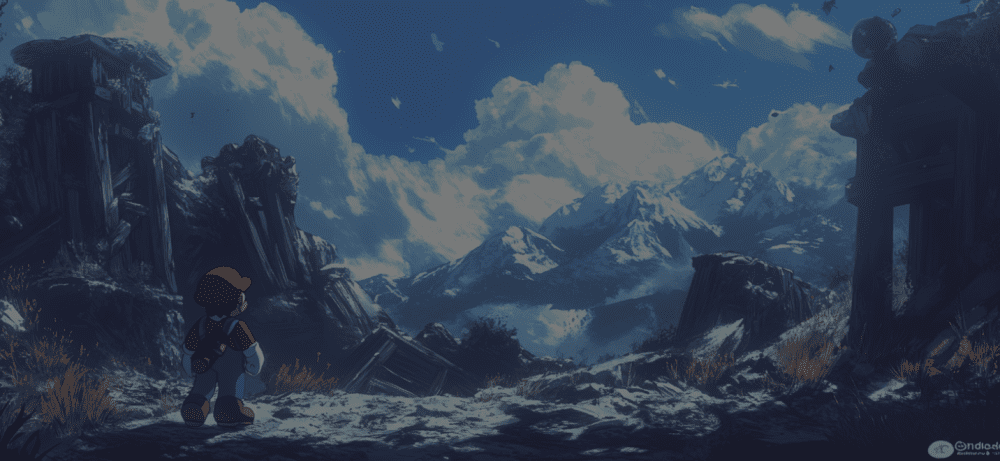Changing the Game: Super Mario Bros., Artificial Intelligence and Teaching to Fail

Changing the Game: Super Mario Bros., Artificial Intelligence and Teaching to Fail
Justin Cary

Let’s ‘a Go
You may not realize it, but teaching and learning have a lot in common with video games.
Think about it for a second. Maybe at some point you picked up a Nintendo controller and tried Super Mario Bros. You took a moment to learn the controls; they were a bit daunting at first; especially nowadays with so many buttons and special moves. Navigating complex 3D worlds can be disorienting at first and perhaps some us (me included) longed for the days of simple, 2D side-scrolling Mario from the 80s; that’s okay, Nintendo still makes Mario games like those! The more you play, the better you get but that confidence comes through trial and error; through playing and learning how to overcome challenges, understanding the game world, learning the rules and through messing up; through falling into pits, losing to enemies, starting over, trying new strategies, at times thinking outside the box to overcome seemingly impossible puzzles and obstacles and eventually you realize the game has been teaching you how to get better at playing it the whole time; all while having a lot of fun. This ‘fun while failing’ is the magic of video games and my AI story actually starts in 1985 when Super Mario Bros. launched. I didn’t know it then (I was only three years old) but video games have been teaching us all about AI for decades and how we might approach this new technology; and linking together (Zelda pun intended) my history with video games and my work with AI sparked new innovations in my approach to using AI in my teaching and learning in exciting new ways.
Extra Lives
I am in the Writing, Rhetoric and Digital Studies Department at UNC Charlotte so I mainly teach First-Year Writing courses and sometimes other Writing Studies courses in our WRDS Major. All of these courses involve the study and practice of writing and since about 2022, I have been working to integrate AI into my pedagogy in the most ethical and responsible ways possible. How can we do this? How can you do this if you have any sort of writing elements in your courses? Perhaps we can look to video games for some inspiration. In the teaching of writing, one key outcome is the focus on the habits formed by writers as they study and develop process. Video games like Super Mario Bros. are all about process; and AI works like this, too. When you pick up a game controller, you are presented with a world that challenges you to explore, try and fail. You learn from your mistakes. Failing is crucial to success in video games. Failing is crucial to success in AI collaboration, too. Understanding that you will need to iterate on a prompt over and over, in conversation with your AI collaborator, tweaking and pushing the AI to get it to, as Ethan Mollick calls it, ‘the jagged-frontier’ is a critical part of the AI co-constructive process. This process can be fun, complex, exhilarating and often, can result in failure. Just like a video game.
Team Work Makes the Dream Work
In my First-Year Writing course, students design an “AI Writing Team” using Charlotte’s Enterprise Gemini account or Enterprise CoPilot account with three distinct personae; these are AI ‘characters’ based on specific needs writing students identify they want to work on in their process. Some writers design team members like Kriss Crumbs, “The Adventurer: For Wringing Your Curiosity and Engagement Out, Kriss is a world-renowned adventurer and kid at heart…who loves to get down to the nitty-gritty of any topic and is known to ignore the phrase ‘curiosity killed the cat’.” Others created personae like “Willow the Wordsmith; a linguistics Ph.D. candidate with a special interest in the technical side of writing. In her spare time, she does a little tutoring on the side and is great at giving feedback on tone, grammar, and structuring concise sentences.” Writers then design, construct and craft AI prompts to go along with these characters, building character-specific, contextualized prompts that result in feedback about their writing through the lens of these writing team members. The last and most crucial step is for students to evaluate this feedback and incorporate it into their writing process; deciding what parts of these responses are useful and actually make their own writing better and which parts can be left behind. Writing students actually build this feedback into drafts as comments, ensuring AI collaboration is always process and the writing that is happening is co-constructive, underscoring the evaluation, core habits of mind that writers need around process, ideation, methodologies, strategies and fundamentals of communication and critical thinking that this AI approach supports. Does it always work? Not always. But failing is part of the game.
“The last and most crucial step is for students to evaluate this feedback and incorporate it into their writing process; deciding what parts of these responses are useful and actually make their own writing better and which parts can be left behind. Writing students actually build this feedback into drafts as comments, ensuring AI collaboration is always process and the writing that is happening is co-constructive, underscoring the evaluation, core habits of mind that writers need around process, ideation, methodologies, strategies and fundamentals of communication and critical thinking that this AI approach supports.”
Other Castles
Working with AI in writing has really changed the game and created new opportunities, and challenges, for how to think about teaching and learning in writing. So the next time you hop in to a game of Super Mario Bros. or the next time you load up your favorite AI platform remember that failure is a powerful teacher and keep going; success may be just one more castle away.